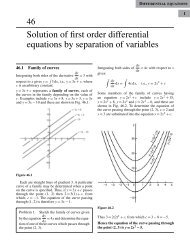differentiation
Create successful ePaper yourself
Turn your PDF publications into a flip-book with our unique Google optimized e-Paper software.
296 DIFFERENTIAL CALCULUS<br />
2<br />
y =<br />
(2t 3 − 5) 4 = 2(2t3 − 5) −4 . Let u = (2t 3 − 5),<br />
then y = 2u −4<br />
Hence<br />
Then<br />
du<br />
dt = 6t2 and dy<br />
du =−8u−5 = −8<br />
u 5<br />
dy<br />
dt = dy<br />
du × du ( ) −8<br />
dt = u 5 (6t 2 )<br />
= −48t2<br />
(2t 3 − 5) 5<br />
Now try the following exercise.<br />
Exercise 120 Further problems on the function<br />
of a function<br />
In Problems 1 to 8, find the differential coefficients<br />
with respect to the variable.<br />
1. (2x 3 − 5x) 5 [5(6x 2 − 5)(2x 3 − 5x) 4 ]<br />
2. 2 sin (3θ − 2) [6 cos (3θ − 2)]<br />
3. 2 cos 5 α [−10 cos 4 α sin α]<br />
[<br />
1<br />
5(2 − 3x 2 ]<br />
)<br />
4.<br />
(x 3 − 2x + 1) 5 (x 3 − 2x + 1) 6<br />
5. 5e 2t+1 [10e 2t+1 ]<br />
6. 2 cot (5t 2 + 3) [−20t cosec 2 (5t 2 + 3)]<br />
7. 6 tan (3y + 1) [18 sec 2 (3y + 1)]<br />
8. 2e tan θ [2 sec 2 θ e tan θ ]<br />
(<br />
9. Differentiate θ sin θ − π )<br />
with respect to θ,<br />
and evaluate, correct to 3 significant figures,<br />
when θ = π [1.86]<br />
2<br />
By successive <strong>differentiation</strong> further higher derivatives<br />
such as d3 y<br />
dx 3 and d4 y<br />
may be obtained.<br />
dx4 Thus if y = 3x 4 , dy<br />
dx = 12x3 , d2 y<br />
dx 2 = 36x2 ,<br />
d 3 y<br />
dx 3 = 72x, d4 y<br />
dx 4 = 72 and d5 y<br />
dx 5 = 0.<br />
Problem 24.<br />
f ′′ (x).<br />
If f (x) = 2x 5 − 4x 3 + 3x − 5, find<br />
f (x) = 2x 5 − 4x 3 + 3x − 5<br />
f ′ (x) = 10x 4 − 12x 2 + 3<br />
f ′′ (x) = 40x 3 − 24x = 4x(10x 2 − 6)<br />
Problem 25. If y = cos x − sin x, evaluate x,in<br />
the range 0 ≤ x ≤ π 2 , when d2 y<br />
is zero.<br />
dx2 Since y = cos x − sin x,<br />
d 2 y<br />
=−cos x + sin x.<br />
dx2 dy<br />
=−sin x − cos x and<br />
dx<br />
When d2 y<br />
is zero, −cos x + sin x = 0,<br />
dx2 i.e. sin x = cos x or sin x<br />
cos x = 1.<br />
Hence tan x = 1 and x = arctan1 = 45 ◦ or π 4 rads<br />
in the range 0 ≤ x ≤ π 2<br />
27.7 Successive <strong>differentiation</strong><br />
When a function y = f (x) is differentiated with<br />
respect to x the differential coefficient is written as<br />
dy<br />
dx or f ′ (x). If the expression is differentiated again,<br />
the second differential coefficient is obtained and<br />
is written as d2 y<br />
(pronounced dee two y by dee x<br />
dx2 squared) or f ′′ (x) (pronounced f double-dash x).<br />
Problem 26.<br />
Given y = 2xe −3x show that<br />
d 2 y<br />
dx 2 + 6dy + 9y = 0.<br />
dx<br />
y = 2xe −3x (i.e. a product)<br />
dy<br />
Hence<br />
dx = (2x)(−3e−3x ) + (e −3x )(2)<br />
=−6xe −3x + 2e −3x










